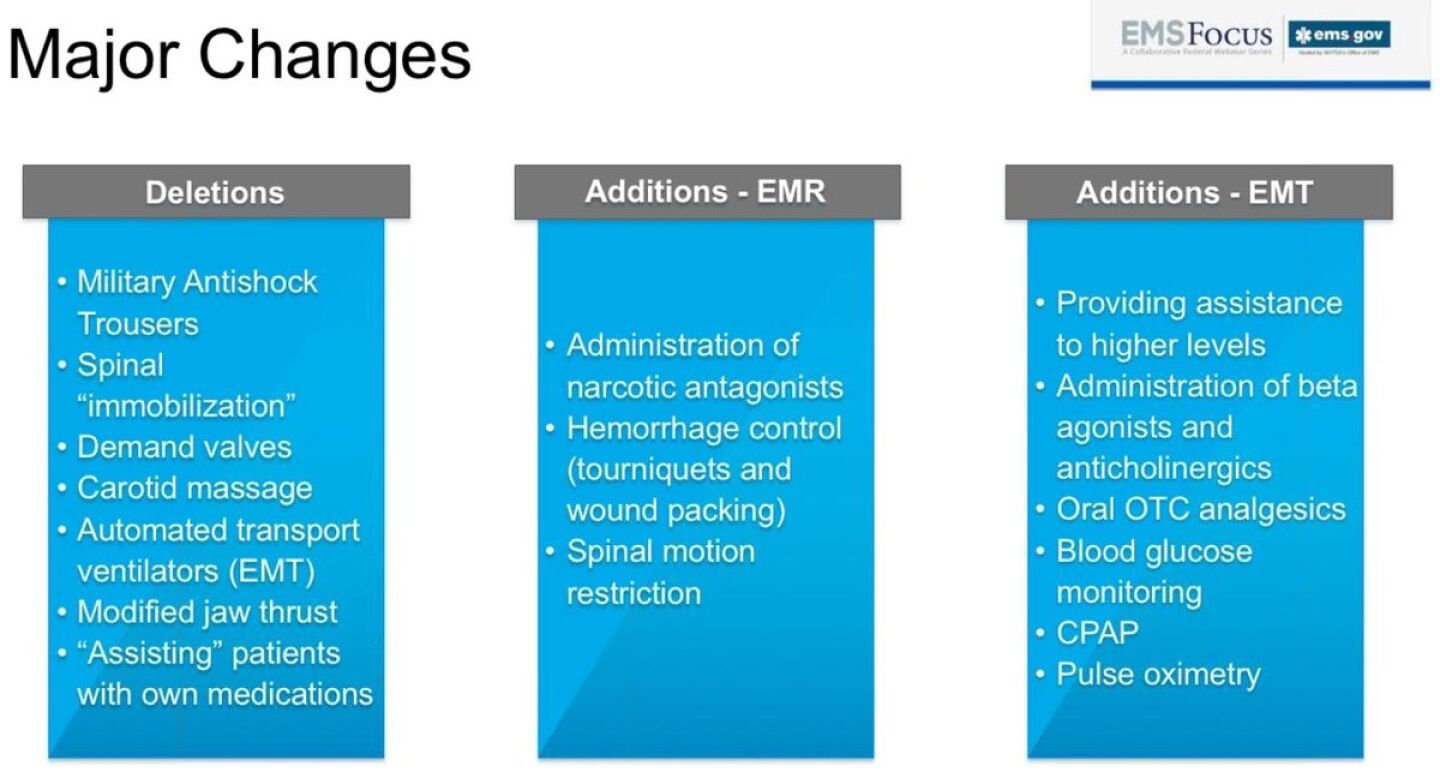Scroll to end of the article to view the full webinar video, The New National Scope of Practice and What it Means for You, and to read the National EMS Scope of Practice Model document. The scope of practice update was featured as an opening presentation at the 2019 NAEMSP Annual Meeting.
The 2018 revision to the National EMS Scope of Practice Model, discussed in an EMS Focus webinar, marks the first significant update to the model since 2007. The revision is sure to have an impact on the education, credentialing and licensure of EMS clinicians for many years.
The National EMS Scope of Practice Model defines the knowledge and skills necessary to achieve competency for each level of EMS clinician:
- EMR
- EMT
- AEMT
- Paramedic
An expert panel led the revision process and members of the panel described the original EMS scope of practice, why revision was critical, and how changes within the profession and medical science over the last decade influenced the National EMS Scope of Practice Model update. The panel gave a quick history of the original EMS scope of practice model as well as the 2007 update, which defined the national licensure levels of EMS personnel in use today and preserved in the 2018 revision.
The panelists also shared insight into many of the decisions they made when working on the revisions and how input was received from the EMS community during the 18-month process. Three rounds of public comment were received and reviewed, after these phases in the process:
- Background narrative
- Provider level descriptions
- Medications/skills list
Practice as an EMS provider is dependent on education, certification of competency, state licensure and medical director credentialing. This image shows how those pieces fit together in the scope of practice.
Memorable quotes on updating the National EMS Scope of Practice Model
Here are four memorable quotes from the December 18 webinar presenters.
“What do you want this person (an EMS provider) to be capable of doing? Then you build the education standard by which you prepared people to do the job.”
- Dan Manz, project champion, 2018 National EMS Scope of Practice Model
“The goal was to provide a tool (for states) to use and even out clinical guidance across the country.”
“The foundation for decisions were based on a look through the evidence and if a change could add clinical value.”
- Scott Bourn, PhD, RN, FACHE, co-chair, 2018 National EMS Scope of Practice Model Project Expert Panel
“The document essentially has been completed. Now it is going through final stages of federal government review. The final document will be available electronically. The content in the most recent draft is unlikely to change in the final federal clearance.”
- Jon Krohmer, MD, director, NHTSA Office of EMS
Top takeaways on 2018 revision to National EMS Scope of Practice Model
The National EMS Scope of Practice Model is the floor or the minimum for EMS provider skills, knowledge and procedures. States can add to the scope of practice or even continue previous practices.
The draft document, proposed by the expert panel, represents the final recommended revision to the 2018 National EMS Scope of Practice Model submitted to the National Highway Traffic Safety Administration. View the draft document, which is pending final federal review, below or download a prepublication PDF version.
When NHTSA releases the updated scope, each state, following its legislative mandates or administrative rules, will follow those processes to adopt or update the scope for their state. The rate of adoption or revision is state specific.
1. Evidence for better patient outcomes
The scope revision was based on reviewing new evidence to make modifications, as necessary. For each of the skills and medications the committee asked two questions:
- Is there evidence that the procedure or skill is beneficial to public health?
- Is there evidence that the procedure or skill can be done safely?
Bourn stressed that the base of evidence should include the best available clinical evidence, expertise and research.
2. Broad, wide-ranging discussion
The scope of practice model is all encompassing to important skills and medication, but was broadened to consider special populations, non-traditional roles like community paramedic and military to civilian transitions.
3. Major changes to EMS scope of practice
Scott Bourn described the major changes in the 2018 National EMS Scope of Practice Model, including deletions from the 2007 model and additions based on current issues, like the opioid crisis, and innovations in equipment and procedures. The deletions from the scope of practice, which Bourn stressed were based on reviewing research – or lack – of efficacy, are:
- Military anti-shock trousers
- Spinal immobilization
- Demand valves
- Carotid massage
- Automated transport ventilators (EMT)
- Modified jaw thrust
- Assisting patients with own medications
4. Updating the National EMS Education Standards
The 2008 EMS Education standards outline the minimal objectives for entry-level EMS education for all four provider levels. The EMS Agenda for 2050 and new scope of practice model will inform the revision of the National Emergency Medical Services Education Standards. A 2-year project is just beginning to revise the education standards by 2021.
Learn more and get involved
Decisions in EMS are most often made by those who show up to participate. Public comment informed the scope of practice update and their will be ample opportunities to participate in the process to revise the National EMS Education Standards. Visit these sites to learn more and review the National EMS Scope of Practice Model document below.
Prepublication Display Copy... by on Scribd







